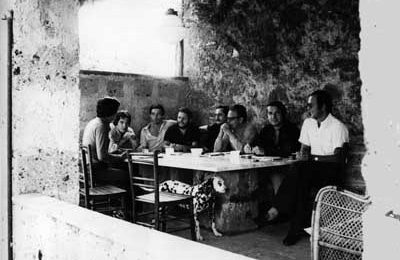You are in: Home page > Magazine Archive > In memory of Carlo Aymonino

Luciano Semerani
In memory of Carlo Aymonino
Adventures without progress

Riunione del Gruppo Architettura nella casa di campagna di Carlo Aymonino - da sinistra: Raffaele Pannella (di schiena), Angelo Villa, Gianni Fabbri, Luciano Semerani, Gianugo Polesello, Carlo Aymonino, Nino Dardi, Romano Burelli
There are those who remain halfway between a dutiful faith in the role of Public Institutions and desperation for human foibles and, like a tightrope walker, attempt to reconcile the opposites. Instead, Carlo lived like a player, who never despairs of his own fate nor in this case that of others, but saw himself and the world with sympathy mixed with deprecation.
Indeed, it is self-deprecation that allows us to give - first and foremost to ourselves - a sense of truth and a value of authenticity to experience.
From Director of the IUAV in Venice from 1974 to 1979, to Councillor for the Historic Centre at the Municipality of Rome from 1980 to 1985, as co-designer, just after graduating, along with Ridolfi and Quaroni of the “Neo-realist Quarter” of Tiburtino, as promoter in Venice of the “Gruppo Architettura” and many, many other cultural initiatives, in companionship with artists, writers, intellectuals, in party militancy Carlo rewarded intelligence, without fearing it, as happened to many, and gave of himself without avarice.
It is in his correspondence with Aldo Rossi, at the time his assistant of Caratteri Distributivi (the spatial arrangement of buildings), the relationship with Guido Canella and the journal Zodiac, the names of the artists he frequented that may be found the reasons for what was then defined “the commitment” to venture beyond. As well as the competence of the academic, the aspirations of the professional, the responsibilities of the professor in a sort of curiosity for the global, and perhaps an immoral passion for the continuous reawakening of the images, for the never-ending adventure along the paths of knowledge.
The enormous stratification of his travel notes, of interpretative drawings of “urban phenomena”, of “eclectic and quoting montages” demonstrates, beyond the actual quality of the works, a sort of “Faustian” search for knowledge, a “Goethian” desire to re-order or better, to “appropriate the world” as it is.
Not that the Presidency of the Venice School was offered to him on a silver platter. The ideological offensive against “the architectural project” was in full swing, and Aymonino, a “formalist” architect represented the rearguard of those who held together the binomial “architecture/city” with the claim of impersonating another binomial, that of “constructors/intellectuals”.
For their own part the ’68 rebels put his capacities for control to the test, based on “playing for time”, perhaps following a family custom of habitual command, and also applying that tolerance towards his neighbour that is a typically Roman gift.
It seemed almost impossible to find a space for Architecture taken among the opposing, but concordant, shores of “territorial planners” and “historians of the death of Art”.
The presence of Aymonino in the “Capitoline Junta” had little effect on the fate of what he read as a single, vast Hadrian’s Villa, a unique “composition” of monuments to be reinterpreted through an accentuation of the relationships between the “signs”, for instance with the “restoration” of the Imperial Forums to their original finished form or with the repositioning of the “Colossus” ̶ designed by himself ̶ between the Coliseum, the Arch of Constantine and the Temple of Venus.
On one of our trips to Milan, Carlo discovered in the window of a clothing shop, some male dressing gowns upon which, in silver on a black background, were printed, unknown to him, reproductions of the “Colossus”, with an inevitably “gay” effect. After the negotiations, Carlo was hushed up with the gift of a dressing gown.
No better luck came to a prestigious international design seminar on the Cannaregio area in Venice, to which were invited important architects (Abram, Eisenman, Hejduk, Hoesli). The project for the area was entrusted to Gregotti, the only one of the school’s lecturers who hadn’t taken part.
Despite not having the minimum effect on the urban history of Venice, that seminar was remarkably important since from that moment on Memory and History became part of the project materials of Eisenman and Hejduk.
In my library in Trieste, the architects are in alphabetical order and distinguished by two different cupboards. The first contains only those who are still active, the second those who are no longer with us. Latterly, I have often had to make some transfers.
With the one I have just made of books by and on Aymonino I think I have finished.
In a copy of the Laterza paperback Il Significato delle Città I found a dedication:
“To Luciano with great affection for almost joint work. Carlo, Nov. 75”
How time has flown and we didn’t even notice!
Luciano Semerani is a Full Professor of Architectural and Urban Composition at the IUAV University of Venice
Luciano Semerani is Full Professor of Urban and Architectural Composition at IUAV, University of Venice













